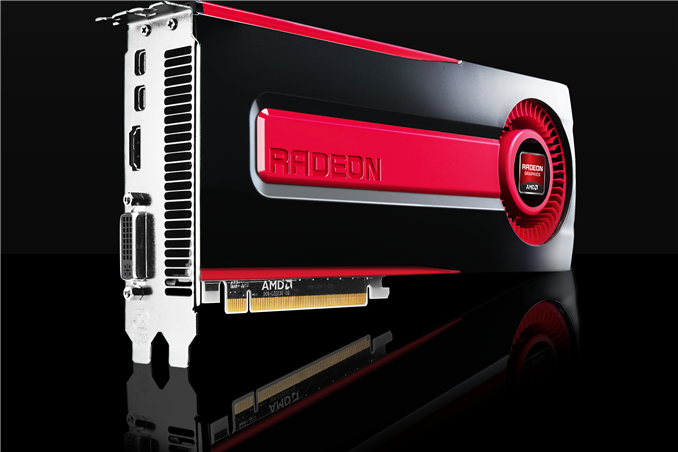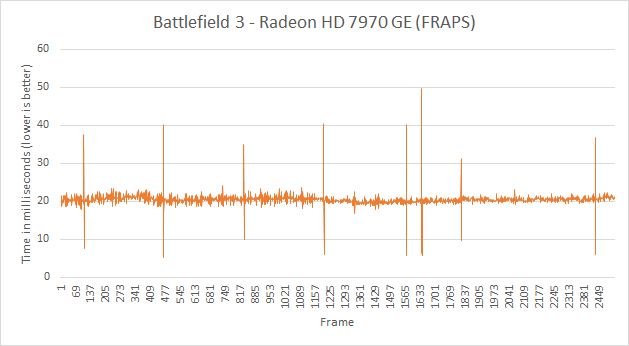AMD Comments on GPU Stuttering, Offers Driver Roadmap & Perspective on Benchmarking
by Ryan Smith on March 26, 2013 2:28 AM EST
For as long as I can remember talking about video cards and GPU performance at AnandTech, there has been debate over the type of benchmarks used to represent that performance. In the old days, the debate was mostly manufacturer driven. Curiously enough, the discourse usually fired up when one manufacturer was at a significant deficit in GPU performance. NVIDIA made a big deal about moving away from timedemos and average frame rates during the early GeForce FX (NV30) days, when its cards might have delivered a decent gaming experience but were slaughtered in most benchmarks. Even Intel advocated for a shift away from most CPU bound gaming benchmarks back during the early years of the Pentium 4 - again, for obvious reasons.
It’s a shame that these revolutions in gaming performance testing were always associated with underperforming products (and later dropped once the product stack improved in the next generation or two). It’s a shame because there has always been merit in introducing additional metrics in order to provide the most complete picture when it came to gaming performance.
The issue lay mostly dormant over the past several years. Every now and then there’d be a new attempt to revolutionize GPU performance testing, but most failed to gain widespread traction for one reason or another. Broad repeatability, one of the basic tenets of the scientific method, was usually cast aside in pursuit of a lot of these new attempts at performance testing - which ultimately limited acceptance.
A year and a half ago, Scott Wasson over at the Tech Report did something no one since Dr. Pabst was able to do: he actually brought about a revolution in the 3D game benchmarking scene.
The approach seemed ridiculously simple - we’ve all had the tools for so very long. Scott used FRAPS to record frame times, and would calculate how long every frame in a benchmark took to render. By focusing on individual frame latencies, Scott’s method could better characterize the little hiccups and stutters that would get smoothed out in an average frame rate. With the new method came a bunch of nifty graphs, and the world changed.

The methodology wasn’t perfect, as FRAPS lacks a holistic view of the 3D rendering pipeline, but it did reveal some surprising issues (in addition to spawning further work that uncovered even more issues on the multi-GPU front). Interestingly enough, many of the issues uncovered by this focus on frame times/latency seemed to primarily impact AMD hardware.
AMD remained curiously quiet as to exactly why its hardware and drivers were so adversely impacted by these new testing methods. While our own foray into evolving GPU testing will come later this week, we had the opportunity to sit down with AMD to understand exactly what’s been going on.
Although neither strictly a defense nor merely an explanation of what we’ve been seeing over the past year, AMD wanted to sit down and better explain their position. This includes both why AMD’s products have been impacted in the manner they were, and why at the same time (and not unlike NVIDIA) AMD is worried about FRAPS being given more weight than it should be. Ultimately AMD believes that it’s to the benefit of buyers and journalists alike to better understand just what is happening, why it’s happening, and just what the most common tools can and are measuring.
What follows is based on our meeting with some of AMD's graphics hardware and driver architects, where they went into depth in all of these issues. In the following pages we’ll get into a high-level explanation of how the Windows rendering pipeline works, why this leads to single-GPU issues, why this leads to multi-GPU issues, and what various tools can measure and see in the rendering process.










103 Comments
View All Comments
Galidou - Saturday, March 30, 2013 - link
Nope, never, I remember Nvidia back in the days of the 6800 GT that caused INFINITE stuttering(worse I've ever seen) with Nforce 3 or was it nforce 4 motherboard that I had. Only thing I could do to fix it was to underclock the video card, go back to older drivers. That made me lose 30-40% performance.They never ever fixed the problem or admitted it, EVER. I had to change video card after 6 months of trying everything. Nvidia forums were full of it not even an answer from them that they were fixing that issue. Some were able to fix this by disabling AGP fastwrites or other tricks but others had no choice doing what I did and lose the performance...
HisDivineOrder - Tuesday, March 26, 2013 - link
It's great that AMD admitted to a problem, but wow what a big problem to have totally missed. I guess they were so busy laying off engineers and R&D they didn't keep ahead of the game.haplo602 - Tuesday, March 26, 2013 - link
all nice and fine, but now please get your arse moving and do something for OpenGL performance AMD !!!kzinti1 - Tuesday, March 26, 2013 - link
If Windows is a major problem with stuttering, then why can't they develop a user-switchable "gaming mode" to make the OS prioritize the resources of the OS in favor of the games and their rendering processes?HisDivineOrder - Tuesday, March 26, 2013 - link
Microsoft is the company that might work something like that out. Unfortunately, Microsoft is also one of the companies that wants you to go buy a console. So I don't think they're going to facilitate what you suggest.I also suspect it's not as simple as what you suggest since it'd require game support, low level changes, etc. But ultimately, it doesn't matter how easy or hard it is because MS won't do it. They have no reason to.
If they cared about PC gaming in the slightest, I think they'd have ported Halo 3, ODST, Halo Reach, Halo 4, Gears of War 2, Gears of War 3, or Fable 2 to PC. Face it. MS gave up on PC gaming. Steam is what kept it going and Steam is what will carry it forward.
And the Steam Box may do exactly what you're suggesting.
mikato - Wednesday, March 27, 2013 - link
I'm pretty sure they care a bit because gaming is the only reason many people still use Windows.mgambrell - Wednesday, March 27, 2013 - link
methinks you place too much confidence in their acumen. As an exercise, find one thing microsoft has done lately which can be spun as plausibly in service of windows gamers.Dribble - Tuesday, March 26, 2013 - link
Fundamentally AMD failed because instead of making a driver to play games well, they make one that's there to give the highest fps at the expense of everything else. They were the first for example they customize the driver for every game - which makes the driver an order of magnitude more complex and introduced a lot more bugs to everything for a few % more performance.They did this because they care about the bottom line numbers shown in reviews more then actually playing the game well. Only now a reviewer has focused on stuttering are they focusing on it. It's not the only problem either - runt frames was also exposed by another tool which if anything is a cheat to exploit fraps - but AMD haven't got as far as discussing that yet.
This is a problem - AMD should be making drivers to play games well, not to look good in reviews. Journalists shouldn't be the ones having to do AMD's driver QA. I can't believe AMD didn't know about the stuttering - it's obvious even with a slow cam, they just didn't think it was important because it didn't effect their sales because journalists weren't reporting on it.
Spoelie - Tuesday, March 26, 2013 - link
Read the article again, your assumptions are wrong.Fixing the stuttering provided an increase in averaged framerates (in cases up to 13%), so it would've made them look a lot better even in traditional reviews not reporting on stuttering. And that's a huge delta for a small software change.
If anything, you could blame them for ineptitude, but there's no ill-will here.
Dribble - Tuesday, March 26, 2013 - link
The increase in fps was a surprise to them. The article suggests that if they had known it would increase fps they would have done it ages ago. Fact is there was stuttering, they knew about it but ignored it - the "well we assumed everyone else stuttered too" excuse isn't great. Clearly it was fixable, and a side effect was it even increased fps, but they were so fixated on fps charts in reviews that it was never deemed important enough to look at until the reviews started castigating them for it.If they had actually been trying to make the card as good as possible for gamers to play with they would have fixed it years ago as stuttering really matters to people trying to play the games.